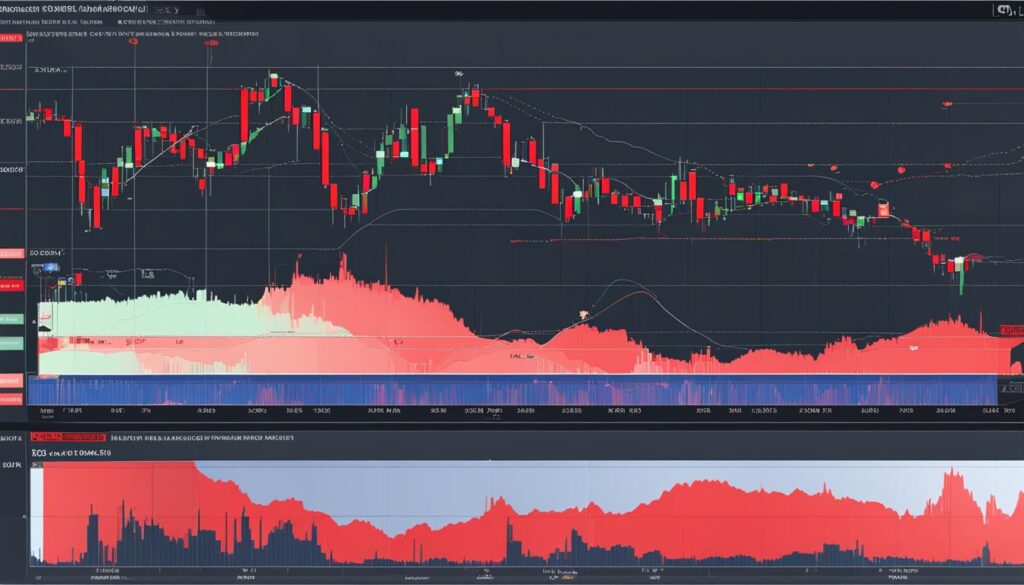As a retail trader, I understand the importance of accessing and navigating spot markets effectively. Spot markets refer to the market where financial instruments, such as commodities or currencies, are traded for immediate delivery. By gaining knowledge and expertise in accessing and navigating these markets, I can optimize my trading strategies and achieve better results. In this article, I will explore the essentials of accessing spot markets and provide guidance on how retail traders can thrive in the trading landscape.
Key Takeaways:
- Spot markets are where financial instruments are traded for immediate delivery.
- Understanding the significance of spot markets is crucial for retail traders.
- Retail traders can access spot markets through online trading platforms, ECNs, or DMA platforms.
- Navigating the spot market landscape requires market analysis and risk management skills.
- Advanced strategies such as technical and fundamental analysis can enhance retail traders’ performance.
Understanding Spot Markets and Their Significance
Spot markets are a crucial component of the trading landscape, providing retail traders with the opportunity for immediate settlement and delivery of financial instruments. Unlike futures or options markets, spot markets facilitate the direct exchange of assets or cash at the current market price, enabling traders to capitalize on real-time market conditions for efficient trade execution. Understanding the significance of spot markets is essential for retail traders to make informed decisions and unlock trading opportunities.
“Spot markets offer retail traders the advantage of instant transactions, allowing them to capitalize on market fluctuations and execute trades efficiently.”
The Significance of Spot Markets
In the trading landscape, spot markets hold significant importance due to their unique characteristics:
- Real-time trading: Spot markets enable retail traders to engage in immediate transactions, eliminating the need for contracts with future delivery dates. This real-time trading feature allows traders to seize market opportunities promptly and adapt to rapidly changing trading conditions.
- Efficient price discovery: Spot markets facilitate transparent price discovery, showcasing the true market value of financial instruments at any given moment. Retail traders can leverage this information to make accurate pricing assessments and execute trades at fair market prices.
- Liquidity: Spot markets are known for their high liquidity, with a constant flow of buyers and sellers. This liquidity ensures that traders can readily buy or sell their positions without significant price slippage, allowing for smooth trade execution.
By understanding these key features, retail traders can strategically navigate the spot market landscape and optimize their trading outcomes.
Spot Market Trading Landscape
The trading landscape in spot markets presents an array of opportunities and challenges for retail traders. To effectively navigate this landscape, traders must:
- Develop a comprehensive understanding of market dynamics and factors influencing price movements.
- Stay informed about market news and events that can impact the value of financial instruments.
- Implement proper risk management strategies to protect capital and minimize potential losses.
- Utilize advanced trading tools and technologies to analyze market trends and identify lucrative trading opportunities.
By mastering these skills and techniques, retail traders can adapt to the ever-changing spot market landscape and enhance their trading performance.
| Benefits of Spot Markets for Retail Traders | Challenges in Spot Market Trading |
|---|---|
| Instant trade execution | Market volatility |
| Transparent price discovery | Competition with institutional traders |
| High liquidity | Market manipulation risks |
Accessing Spot Markets as a Retail Trader
Retail traders have various options when it comes to accessing spot markets. One popular method is through online trading platforms provided by brokers. These platforms offer access to a wide range of spot markets, enabling traders to buy and sell different financial instruments.
“Online trading platforms provide convenience and flexibility for retail traders to access spot markets.”
Electronic communication networks (ECNs) and direct market access (DMA) platforms also serve as avenues for retail traders to access spot markets. These platforms allow traders to directly interact with the market, bypassing intermediaries and gaining faster order execution.
It is crucial for retail traders to choose a reliable and reputable platform that caters to their specific needs. When selecting a trading platform, retail traders should consider factors such as competitive pricing, user-friendly interface, and advanced trading tools.
Comparison of Popular Trading Platforms
| Platform | Features | Pricing |
|---|---|---|
| Platform A | Advanced charting tools, real-time market data, customizable interface | Competitive commission fees, no hidden charges |
| Platform B | Access to a wide range of spot markets, mobile trading app | Low spreads, transparent pricing |
| Platform C | Social trading features, copy trading functionality | No commission fees, markup on spreads |
Each platform has its own unique features and pricing structure, so it’s important for retail traders to carefully evaluate their options and choose the platform that best aligns with their trading goals and preferences.
By leveraging the capabilities of these trading platforms, retail traders can access spot markets efficiently and take advantage of trading opportunities in real-time.
Navigating the Spot Market Landscape
When it comes to navigating spot markets, retail traders must equip themselves with essential skills such as market analysis and risk management. By delving into market analysis, traders can discern trends, identify potential trading opportunities, and make informed decisions. Effective execution of trades based on thorough market analysis is vital for success in spot markets.
Moreover, risk management strategies play a pivotal role in protecting capital and minimizing losses. Implementing techniques like setting stop-loss orders and diversifying investments can safeguard retail traders from significant downturns. With proper risk management, traders can confidently navigate the spot market landscape.
“Market analysis and risk management are the navigational tools that empower me to make calculated decisions in spot markets.”
Importance of Market Analysis
Market analysis is a fundamental aspect of navigating the spot market landscape. By closely monitoring market trends, traders can identify patterns, determine market sentiment, and spot potential entry or exit points. Through comprehensive analysis, traders gain insight into supply and demand dynamics, market volatility, and other factors influencing price movements.
Risk Management Strategies
Implementing effective risk management strategies is essential to protect investments and maintain long-term profitability. Traders should establish predetermined risk levels and set stop-loss orders to limit potential losses. Furthermore, diversifying investments across different asset classes and markets can mitigate overall risk exposure, ensuring a balanced and resilient portfolio.
Developing the Skillset
To thrive in spot markets, retail traders must continuously develop their skillset in market analysis and risk management. Staying updated with market news, utilizing technical analysis tools and indicators, and honing analytical abilities are crucial for navigating the ever-changing spot market landscape.
| Market Analysis Techniques | Risk Management Strategies |
|---|---|
| Technical analysis | Setting stop-loss orders |
| Fundamental analysis | Diversifying investments |
| Sentiment analysis | Implementing position-sizing techniques |
| Pattern recognition | Using trailing stops |
Advanced Strategies for Retail Traders in Spot Markets
When it comes to trading in spot markets, retail traders can significantly enhance their performance by implementing advanced strategies. These strategies involve leveraging various analytical techniques to gain insights into market trends and make informed trading decisions. In this section, I will discuss two key approaches that retail traders can utilize: technical analysis and fundamental analysis.
Technical Analysis
Technical analysis is a widely used strategy that involves studying price patterns, indicators, and historical market data to predict future price movements. By analyzing charts and identifying patterns, retail traders can determine potential entry and exit points for their trades. Technical analysis helps traders understand market sentiment, identify trends, and make informed decisions based on historical price data.
Some popular technical analysis tools include:
- Candlestick charts
- Trend lines
- Support and resistance levels
- Moving averages
- Relative strength index (RSI)
By utilizing these tools and indicators, retail traders can gain a better understanding of market conditions and make more accurate predictions.
Fundamental Analysis
While technical analysis focuses on price movements and historical data, fundamental analysis examines the underlying factors that drive market movements. This approach involves evaluating economic indicators, financial statements, company news, and other relevant data to determine the intrinsic value of an asset.
Fundamental analysis provides insights into the overall health and value of an asset or market. Retail traders can assess factors such as economic indicators, company earnings, industry trends, and geopolitical news to identify potential trading opportunities.
“Fundamental analysis helps retail traders understand the bigger picture and make informed decisions based on the actual value of an asset.”
Combining Technical and Fundamental Analysis
While technical analysis and fundamental analysis are often seen as separate strategies, many successful retail traders combine both approaches to gain a comprehensive understanding of spot markets.
By incorporating technical analysis tools and indicators alongside fundamental analysis insights, traders can make more informed and strategic trading decisions. Analyzing price trends and patterns in combination with evaluating the underlying market and economic factors can provide a more accurate assessment of trading opportunities.
Continuously Updating Knowledge and Skills
Spot markets are dynamic and constantly evolving, making it essential for retail traders to continuously update their knowledge and skills. Staying informed about new analytical techniques, market trends, and industry news will ensure traders remain competitive and adaptable in the ever-changing trading environment.
| Benefits of Advanced Strategies | Technical Analysis | Fundamental Analysis |
|---|---|---|
| Identify entry and exit points for trades | ✔️ | ❌ |
| Assess market sentiment and trends | ✔️ | ❌ |
| Evaluate intrinsic value of assets | ❌ | ✔️ |
| Understand market and economic factors | ❌ | ✔️ |
Conclusion
Accessing and navigating spot markets as a retail trader requires knowledge, skills, and the right tools. As I have explored in this article, understanding the significance of spot markets is crucial for retail traders to make informed decisions and capitalize on trading opportunities. By selecting reliable trading platforms and mastering market analysis techniques, retail traders can optimize their trading strategies and achieve success in the dynamic trading landscape.
Continuous learning and adaptation are essential for retail traders to stay ahead in spot markets. The trading landscape is constantly evolving, and staying updated with market changes is crucial. By continuously expanding knowledge and updating skills, retail traders can effectively navigate the spot market landscape and thrive in the trading industry.
As a retail trader, accessing spot markets opens a world of opportunities. It is vital to choose the right trading platforms that offer competitive pricing, user-friendly interfaces, and advanced trading tools. Additionally, mastering market analysis techniques, such as technical and fundamental analysis, can help retail traders make more informed trading decisions.
To achieve success in spot markets, retail traders must be proactive in their approach and adapt to market changes. By combining knowledge, skills, and the right tools, retail traders can navigate the trading landscape and seize profitable trading opportunities.
FAQ
What are spot markets?
Spot markets are where financial instruments, such as commodities or currencies, are traded for immediate delivery at the current market price.
How can retail traders access spot markets?
Retail traders can access spot markets through online trading platforms provided by brokers, electronic communication networks (ECNs), or direct market access (DMA) platforms.
What skills do retail traders need to navigate the spot market landscape?
Retail traders need to develop skills in market analysis, risk management, and continuous learning to navigate the spot market landscape successfully.
What are some advanced strategies for retail traders in spot markets?
Advanced strategies include technical analysis, which involves studying price patterns and indicators, and fundamental analysis, which evaluates underlying factors that drive market movements.
How can retail traders optimize their trading strategies in spot markets?
Retail traders can optimize their trading strategies by understanding the significance of spot markets, selecting reliable trading platforms, and continuously updating their knowledge and skills.
Source Links
Disclaimer
All information on this website is of a general nature. The information is not adapted to conditions that are specific to your person or entity. The information provided can not be considered as personal, professional or legal advice or investment advice to the user.
This website and all information is intended for educational purposes only and does not give financial advice. Signal Mastermind Signals is not a service to provide legal and financial advice; any information provided here is only the personal opinion of the author (not advice or financial advice in any sense, and in the sense of any act, ordinance or law of any country) and must not be used for financial activities. Signal Mastermind Signals does not offer, operate or provide financial, brokerage, commercial or investment services and is not a financial advisor. Rather, Signal Mastermind Signals is an educational site and a platform for exchanging Forex information. Whenever information is disclosed, whether express or implied, about profit or revenue, it is not a guarantee. No method or trading system ensures that it will generate a profit, so always remember that trade can lead to a loss. Trading responsibility, whether resulting in profits or losses, is yours and you must agree not to hold Signal Mastermind Signals or other information providers that are responsible in any way whatsoever. The use of the system means that the user accepts Disclaimer and Terms of Use.
Signal Mastermind Signals is not represented as a registered investment consultant or brokerage dealer nor offers to buy or sell any of the financial instruments mentioned in the service offered.
While Signal Mastermind Signals believes that the content provided is accurate, there are no explicit or implied warranties of accuracy. The information provided is believed to be reliable; Signal Mastermind Signals does not guarantee the accuracy or completeness of the information provided. Third parties refer to Signal Mastermind Signals to provide technology and information if a third party fails, and then there is a risk that the information may be delayed or not delivered at all.
All information and comments contained on this website, including but not limited to, opinions, analyzes, news, prices, research, and general, do not constitute investment advice or an invitation to buy or sell any type of instrument. Signal Mastermind Signals assumes no responsibility for any loss or damage that may result, directly or indirectly, from the use or dependence on such information.
All information contained on this web site is a personal opinion or belief of the author. None of these data is a recommendation or financial advice in any sense, also within the meaning of any commercial act or law. Writers, publishers and affiliates of Signal Mastermind Signals are not responsible for your trading in any way.
The information and opinions contained in the site are provided for information only and for educational reasons, should never be considered as direct or indirect advice to open a trading account and / or invest money in Forex trading with any Forex company . Signal Mastermind Signals assumes no responsibility for any decisions taken by the user to create a merchant account with any of the brokers listed on this website. Anyone who decides to set up a trading account or use the services, free of charge or paid, to any of the Broker companies mentioned on this website, bears full responsibility for their actions.
Any institution that offers a service and is listed on this website, including forex brokers, financial companies and other institutions, is present only for informational purposes. All ratings, ratings, banners, reviews, or other information found for any of the above-mentioned institutions are provided in a strictly objective manner and according to the best possible reflection of the materials on the official website of the company.
Forex/CFD trading is potentially high risk and may not be suitable for all investors. The high level of leverage can work both for and against traders. Before each Forex/CFD investment, you should carefully consider your goals, past experience and risk level. The opinions and data contained on this site should not be considered as suggestions or advice for the sale or purchase of currency or other instruments. Past results do not show or guarantee future results.
Neither Signal Mastermind Signals nor its affiliates ensure the accuracy of the content provided on this Site. You explicitly agree that viewing, visiting or using this website is at your own risk.




